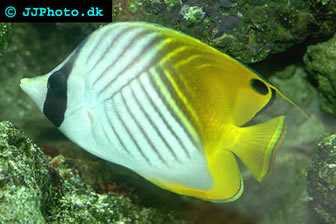Threadfin Butterflyfish
Chaetodon auriga
The fish species Chaetodon auriga is known under many different common names in English, including Threadfin Butterflyfish, Threadfin Butterfly, Threadfin Coralfish, Cross-stripe butterfly, Whip Butterflyfish, and Auriga Butterflyfish.
Chaetodon auriga has not been evaluated for the IUCN Red List of Threatened Species.
Geograhical range, habitat and habits
The Threadfin Butterflyfish is found in the Indo-Pacific. Its geographical range stretches from eastern Africa (down to Mossel Bay, South Africa) and the Red Sea to Hawaii and the Marquesas and Ducie Islands of French Polynesia. The northern border of their range is found south of Japan, while the southern border is located near the Lord Howe (Australia) and Rapa Islands (French Polynesia).
The Threadfin Butterfly is a reef-associated fish and its does not migrate. Its depth range is 1-35 meters / 3-115 feet. It can be found in several different types of habitats, including corals reefs (inner and outer reef slopes), inshore waters and rubble covered bottoms with prolific plant and algae growth. The Threadfin Butterfly appreciates environments where there are plenty of caves and similar to hide in, but also plenty of open space to swim around in. This species can be found singly, in pairs, or in aggregations. When an aggregation has been formed, it will usually roam over large areas looking for food.
Size and appearance
The largest scientifically measured 23 cm / 9 in.
The base colour of this fish is white and the sides of the body feature a pattern of dark chevron (zigzag) markings. The rear of the body, including the caudal peduncle, is yellow.
In adult fish, a black vertical band runs across the eye and a filament trails posteriorly from the upper soft portion of the dorsal fin. Juveniles are instead decorated with a black bar over the head which covers the eye and there is also an eye-sized black dot on the soft dorsal fin.
The exact colour and patterns of this fish will vary from region to region.
Threadfin Butterflyfish care
The Threadfin Butterflyfish is fairly hardy and can easily be trained to accept many different types of food in the aquarium. It can be recommended for novice marine aquarists because fulfilling its needs is not very tricky as long as you are prepared to read up and devote sufficient amounts of time to your aquarium. It is however best to wait until you have a well established and stable aquarium before introducing this species.
The Threadfin Butterflyfish can reach a size of 23 cm / 9 in and does not handle crowding well, so a rather big aquarium will be necessary. A small specimen will need at least 15 gallons / 60 litres and a larger fish should not be kept in aquarium smaller than 30 gallons / 120 litres. Many aquarists recommended housing it in a 50 gallon / 200 L aquarium or larger since it is sensitive to organic waste. It is very important to include many suitable hiding spots in the set up.
Keep the water temperature at 72-78º F / 22-25.5º C, the pH-value at 8.2-8.4
and the specific gravity between 1.021 and 1.023.
This is a peaceful species but it is not really a reef compatible fish since likes to eat invertebrates. It can be kept with live-rock, but it will pick at the rock. If you keep more than one Butterflyfish (regardless of species) in the aquarium they might fight each other, especially if they are similar in size and shape. Crowding the aquarium will increase the risk dramatically, while a large and roomy aquarium that is cleverly decorated will reduce the risk. Other fish species will normally leave Butterflyfish alone since they don’t with to get close to the spines. There are however species that will nip at the delicate fins.
The Threadfin Butterflyfish can hybridize with Chaetodon lunula and Chaetodon ephippium.
Feeding Threadfin Butterflyfish
This is an omnivore species. In the wild, the Threadfin Butterflyfish feeds chiefly by tearing pieces from annelid worms, coral polyps, and sea anemones, and it is also fond of algae.
In the aquarium, it is fairly easy to train the Threadfin Butterfly to accept fresh, frozen and freeze dried food, and it is also known to happily gulp down vegetables such as broccoli and asparagus. You can for instance give your fish fillets, shrimps and plankton. Preferably include some type of algae based food in its diet, especially if you do not have a lot of natural algae growth in your tank. It is better to give your fish many small servings of food throughout the day than one or two big ones.
If your Threadfin Butterflyfish refuses to eat, try enticing it with live food, e.g. brine shrimp or a freshly opened clam.
Breeding Threadfin Butterflyfish
The Threadfin Butterflyfish is an egg-laying species that will scatter its eggs. They are often encountered as pairs in the wild. During spawning, the female will release her eggs in mid-water and the male will fertilize them. Spawning seems to be triggered by tidal movements and the lunar cycle. The larvae of the Threadfin Butterflyfish will go through an “armoured” stage when they drift around in the ocean as free-floating plankton.
Butterflyfish Articles:
Copperbanded Butterflyfish – Chelmon rostratus
Golden Butterflyfish – Chaetodon semilarvatus
Klien's Butterflyfish – Chaetodon kleinii
Lined Butterflyfish – Chaetodon lineolatus
Longfin Bannerfish – Heniochus acuminatus
Raccoon Butterflyfish – Chaetodon lunula
Saddleback Butterflyfish – Chaetodon falcula
Schooling Bannerfish – Heniochus diphreutes
Yellow Longnose Butterflyfish – Forcipiger flavissimus

